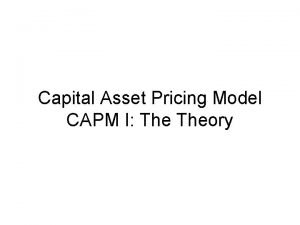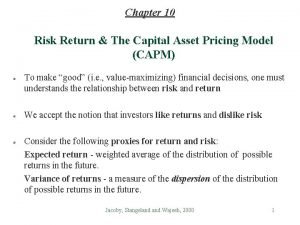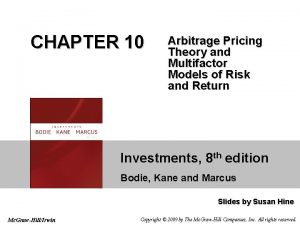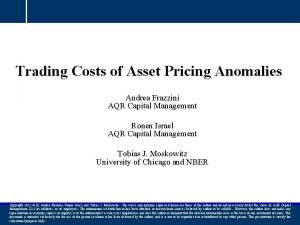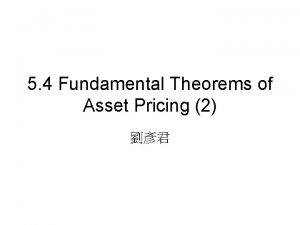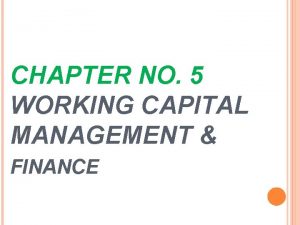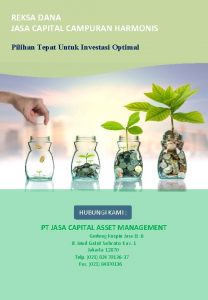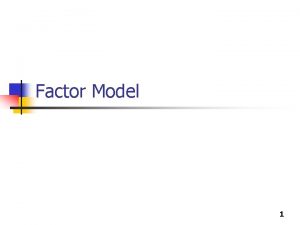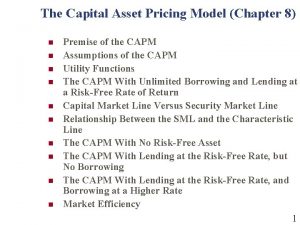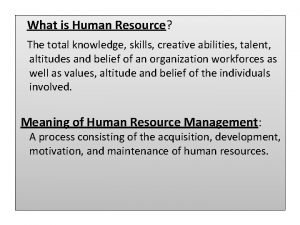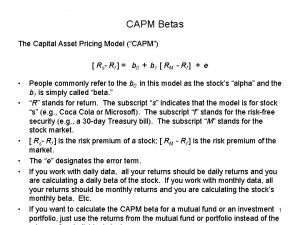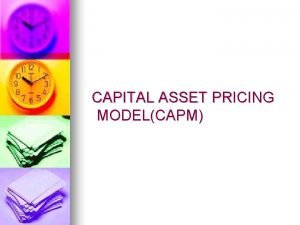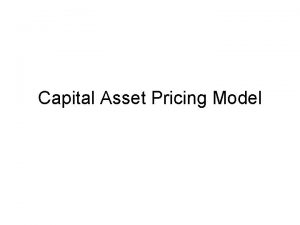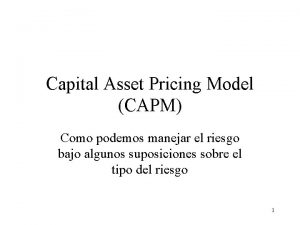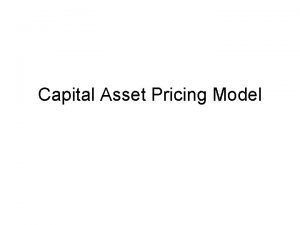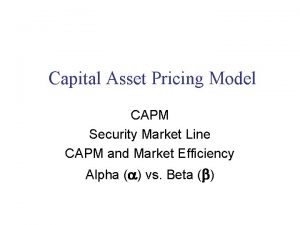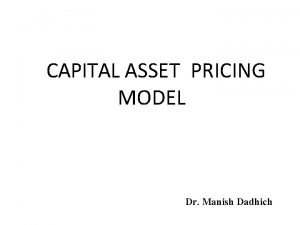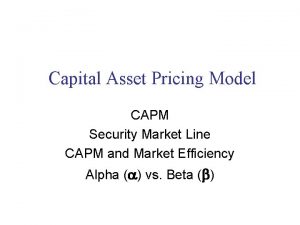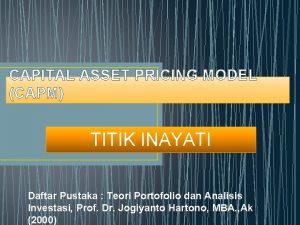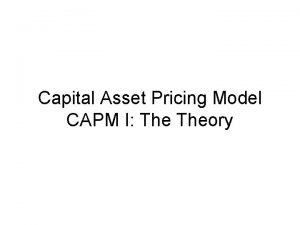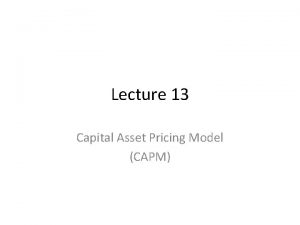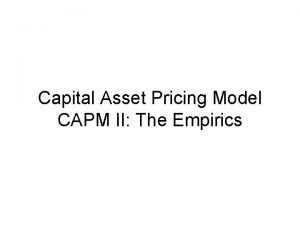The Capital Asset Pricing Model CAPM The CAPM
























- Slides: 24

The Capital Asset Pricing Model (CAPM) • The CAPM has – A macro component explains risk and return in a portfolio context – A micro component explains individual stock returns – The micro component is also used to value stocks Copyright © 2003 South-Western/Thomson Learning. All rights reserved.

The Capital Market Line • The capital market line – adds a risk-free return – redefines the efficient frontier Copyright © 2003 South-Western/Thomson Learning. All rights reserved.

The Capital Market Line Copyright © 2003 South-Western/Thomson Learning. All rights reserved.

Risk and Return • The investor continues to select the portfolio that – offers the highest return for a given level of risk – maximizes satisfaction • Different investors may select different combinations of risk and return Copyright © 2003 South-Western/Thomson Learning. All rights reserved.

Risk and Return • Different asset classes lie on the capital market line Copyright © 2003 South-Western/Thomson Learning. All rights reserved.

Beta Coefficients • An index of risk • Measures the volatility of a stock (or portfolio) relative to the market Copyright © 2003 South-Western/Thomson Learning. All rights reserved.

Beta Coefficients Combine • The variability of the asset’s return • The variability of the market return • The correlation between – the stock's return and – the market return Copyright © 2003 South-Western/Thomson Learning. All rights reserved.

Beta Coefficients • Beta coefficients are the slope of the regression line relating – the return on the market (the independent variable) to – the return on the stock (the dependent variable) Copyright © 2003 South-Western/Thomson Learning. All rights reserved.

Beta Coefficients Copyright © 2003 South-Western/Thomson Learning. All rights reserved.

Interpretation of the Numerical Value of Beta • Beta = 1. 0 Stock's return has same volatility as the market return • Beta > 1. 0 Stock's return is more volatile than the market return Copyright © 2003 South-Western/Thomson Learning. All rights reserved.

Interpretation of the Numerical Value of Beta Copyright © 2003 South-Western/Thomson Learning. All rights reserved.

Interpretation of the Numerical Value of Beta • Beta < 1. 0 Stock's return is less volatile than the market return Copyright © 2003 South-Western/Thomson Learning. All rights reserved.

Interpretation of the Numerical Value of Beta Copyright © 2003 South-Western/Thomson Learning. All rights reserved.

High Beta Stocks • More systematic market risk • May be appropriate for high-risk tolerant (aggressive) investors Copyright © 2003 South-Western/Thomson Learning. All rights reserved.

Low Beta Stocks • Less systematic market risk • May be appropriate for low-risk tolerant (defensive) investors Copyright © 2003 South-Western/Thomson Learning. All rights reserved.

Individual Stock Betas • May change over time • Tendency to move toward 1. 0, the market beta Copyright © 2003 South-Western/Thomson Learning. All rights reserved.

Portfolio Betas • Weighted average of the individual asset's betas • May be more stable than individual stock betas Copyright © 2003 South-Western/Thomson Learning. All rights reserved.

Beta Coefficients and The Security Market Line • The return on a stock depends on – the risk free rate (rf) – the return on the market (rm) – the stock's beta – the return on a stock: k= rf + (rm - rf)beta Copyright © 2003 South-Western/Thomson Learning. All rights reserved.

Beta Coefficients and The Security Market Line • The figure relating systematic risk (beta) and the return on a stock Copyright © 2003 South-Western/Thomson Learning. All rights reserved.

Beta Coefficients and The Security Market Line Copyright © 2003 South-Western/Thomson Learning. All rights reserved.

Arbitrage Pricing Theory (APT) • In the CAPM – a stock's return depends only on • the market return • the volatility of the stock (the beta) • APT is an alternative to the Capital Asset Pricing Model Copyright © 2003 South-Western/Thomson Learning. All rights reserved.

Arbitrage • Buying in one market and simultaneously selling in another market to take advantage of price differentials • Assures there can be only one price • Assures that portfolios with the same risk will have the same returns Copyright © 2003 South-Western/Thomson Learning. All rights reserved.

APT explains security returns in terms of • The expected return • A series of factors that may affect security prices • How the individual stock responds to unanticipated changes in those factors Copyright © 2003 South-Western/Thomson Learning. All rights reserved.

Common Factors • Unexpected inflation • Unexpected changes in industrial production • Unanticipated shifts in risk premiums • Unanticipated changes in the structure of yields Copyright © 2003 South-Western/Thomson Learning. All rights reserved.
 Capm equilibrium
Capm equilibrium مدل capm در اکسل
مدل capm در اکسل Capm in excel
Capm in excel Calculate expected portfolio return
Calculate expected portfolio return Multifactor asset pricing model
Multifactor asset pricing model Abb ellipse eam
Abb ellipse eam Andrea frazzini aqr
Andrea frazzini aqr Fundamental theorem of asset pricing proof
Fundamental theorem of asset pricing proof What is working capital cycle
What is working capital cycle Human capital intangible asset
Human capital intangible asset Capital allocation line
Capital allocation line Jasa capital asset management
Jasa capital asset management Kospin jasa
Kospin jasa Capm model
Capm model Assumption of capm
Assumption of capm Gross working capital
Gross working capital Difference between capital reserve and reserve capital
Difference between capital reserve and reserve capital Multinational capital structure
Multinational capital structure Difference between capital reserve and reserve capital
Difference between capital reserve and reserve capital Regulatory capital vs economic capital
Regulatory capital vs economic capital Regulatory capital vs economic capital
Regulatory capital vs economic capital Constant capital and variable capital
Constant capital and variable capital Multinational cost of capital and capital structure
Multinational cost of capital and capital structure Capital allocation line vs capital market line
Capital allocation line vs capital market line Lev and schwartz model advantages and disadvantages
Lev and schwartz model advantages and disadvantages
